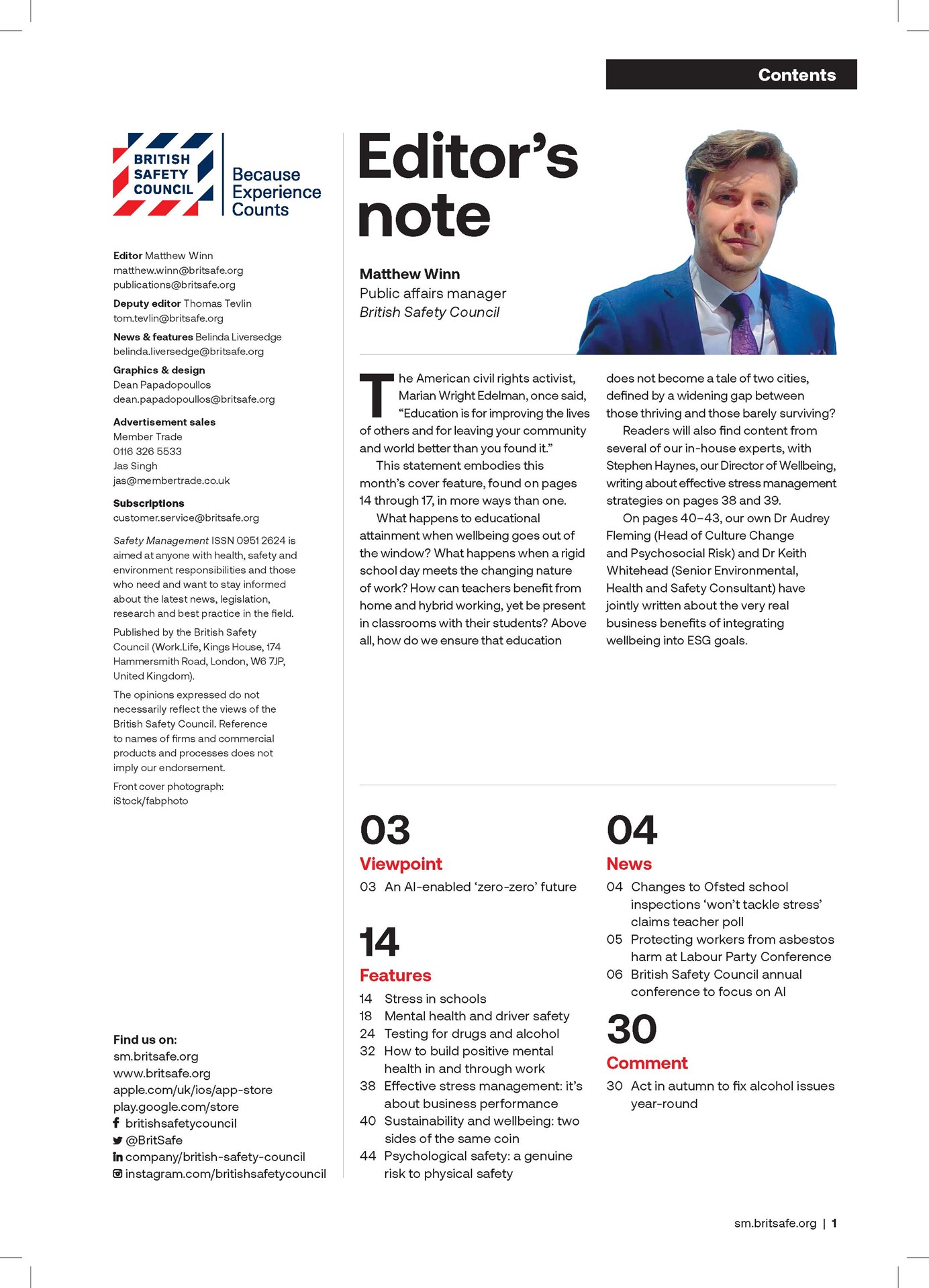The move to renewable and low carbon energy sources like hydrogen will clearly present new safety risks, but developments in technology like gas detection monitoring will help to keep workers and the public safe.
Features
The energy transition: why we need to manage the safety risks
Despite some significant setbacks in 2022 – notably the conflict in Ukraine which led to rising energy costs and declining energy security and contributed to a refocus on fossil fuels – the energy transition in the UK continues to gather pace. As a result, we saw a record volume of energy generated from renewable sources, with solar, wind, biomass and hydropower contributing 40 per cent of all electricity produced and reports of the UK becoming a net exporter of electric power for the first time in 10 years.
 Photograph: Draeger Safety UK
Photograph: Draeger Safety UK
Yet despite this, it is clear that the proportion of renewable energy supply generated in the UK will need to accelerate further if we are to achieve our national net zero targets and as a result it is important that we continue to see a clear – and in many areas of new energy, rapid – direction of travel in order to meet UK and global climate change goals.
While it is acknowledged that progress is being made in the use of renewable energy, there is a pressing need for greater understanding of the safety considerations, and risk amelioration of new energy sources and applications – not least to build public confidence in the new technology as a safe and dependable energy source for the future.
At present, a widespread misalignment exists between the perception of renewable energy and environmental initiatives as ‘green, clean and therefore safe’, and the reality, which is that in fact, the risks are often not dissimilar to those seen in the oil and gas industries. The key difference being that such legacy energy sectors are often seen as ‘black, dirty and dangerous’, with the consequence being that safety is viewed as a crucial consideration, and is, as a result, mature and well-advanced in such industries.
So, while most people would agree that a move away from a carbon-based economy should be carried out as quickly as possible, this must not be at the expense of safety. Failure to consider adequately the safety elements within the renewables energy industry may well lead to setbacks which have the potential to harm the overall goal of reducing carbon emissions and protecting the planet for future generations.
To be clear, when new energy safety is done well, there is little, if any difference in risks compared with many other hazardous industry sectors, but it is important that the safety risks are fully understood, both where they are similar to the traditional energy sector and where they differ.
Similar and different risks
Firstly, let us consider the similarities. These include confined spaces, fire hazards and exposure to flammable and toxic gases; risks which are present in the renewable energy sector, often in a similar way to the oil and gas sector, and often in a way which will be familiar to health and safety professionals.
 David Head is head of safety marketing at Draeger Safety UK. Photograph: Draeger Safety UK
David Head is head of safety marketing at Draeger Safety UK. Photograph: Draeger Safety UK
Where new energy technologies differ from the traditional oil and gas sector largely centres around improving our understanding of the unique risks imposed by the use of electric vehicle (EV) batteries and storage of carbon dioxide (CCUS) and other gases such as hydrogen.
The hydrogen economy is widely considered to be one of the most important sources of new energy and an essential part of the UK’s future energy independence and security, as well as our commitment to achieve net zero by 2050.
Green hydrogen – produced by electrolysis, harnessing wind or solar power and considered to be the only sustainable hydrogen solution in the long term – can be produced where energy is generated and distributed to top up energy supplies.
Hydrogen use is already being ramped up at all levels. Within the next 10 years, hydrogen-powered transport, blended hydrogen heating, industry heat and feedstock, and power generation with hydrogen are expected to have a significant mass-market impact.
It is therefore vitally important that we work to improve education and awareness of hydrogen safety for operators handling hydrogen equipment for storage and transportation, and that engineers are fully trained in understanding the safety risks. It is also crucial that the importance of hydrogen safety is fully appreciated and considered not just by operators but at board level.
Collaboration between industry and academia
However, to fully understand the risks of new fuel sources, such as hydrogen, we believe there will have to be collaboration between industry and academia. For this reason, Dräger has been working with the University of Aberdeen for several years, both supporting their students’ understanding of the safety risks and also working to keep these same students safe when conducting research in the lab and when using gases such as hydrogen. We believe that collaboration of this kind is vitally important to support the development of safety strategies in industry, and transparent communication to the public to help establish a successful and safe hydrogen economy.
It is therefore crucial to recognise the safety hazards that accompany new technology. For example, when it comes to handling, storing and transporting hydrogen, safety protocols are critical, and the establishment of standardised and recognised safety standards is essential.
 Photograph: Draeger Safety UK
Photograph: Draeger Safety UK
In parallel to developments around new energy sources, there are also advances being made in safety technology to secure the safety of employees and other assets. This is particularly relevant in hazardous environments where gases, such as hydrogen, are not only highly flammable but also colourless and odourless, posing an enhanced risk of fire or explosion.
In these situations, improvements in connectivity offer a number of key benefits, including live monitoring of gas levels such as hydrogen, with key information displayed in real time via a connected user interface. This digitalisation of safety systems means that alarms can be set, ventilation automatically activated and, if required, emergency services can be granted access to the data which allows them to manage an emergency situation in the case of, for example, a hydrogen-generated fire.
Furthermore, businesses can add an extra layer of monitoring to a standard gas detection solution by using complementary sensor devices such as acoustic and flame detection. Doing so can safeguard valuable company and plant equipment and may also prevent a catastrophic fire or explosion.
Advancements in gas detection technology
Another advancement in safety technology that has been prompted by the use of new fuels such as hydrogen is the implementation of acoustic gas detectors as a supplementary technology. These allow for the detection of gas leaks emanating from pressurised gas storage, particularly in outdoor or ventilated locations where conventional detectors may fail to pick up on leaks due to wind conditions, gas dilution or leak directionality.
These ultrasonic acoustic sensors respond earlier than traditional gas detectors by registering the sound of leaking gas, effectively ‘hearing’ the gas leak. In doing so, acoustic detectors don’t require or rely on any physical contact between the gas and the sensor, enabling coverage of a much wider area, and detecting leaks up to 20 metres away. Importantly, they are not gas-specific so can be used to detect leaks of any gas type.
Returning to the hydrogen example, these detectors can be particularly effective when it comes to hydrogen. Hydrogen molecules are around eight times smaller than methane molecules, which makes leaks far more likely and because hydrogen burns with a flame that is almost invisible to the naked eye and is odourless, it is more difficult to detect. However, the use of acoustic detection of leaks greatly reduces the risk of explosion, minimises the financial cost of leaks and is particularly effective in settings where hydrogen is stored.
As far back as 2020, a report by the trade union Prospect stated that the rate of lost time to injuries in offshore renewables was four times as high as in offshore oil and gas, itself a high hazard industry. The Health and Safety Executive (HSE) also reported concerns around this time that progress in safety in the sector appeared to have stalled.
Furthermore, it is notable that one of the key themes raised in the 2021 Safety at Work report published by Dräger around the topic, revealed concerns that safety protocols and regulations in the UK’s renewable energy sector were failing to keep pace with the broader speed of progress within the sector.
Encouraging signs
There are however some encouraging signs that as the renewable sector grows, it is beginning to recognise the fundamental importance of safety. Independent research commissioned by Dräger in 2022 showed that 82 per cent of the UK’s new and renewable energy sector workforce think safety has increased in importance within their business compared with the previous year.
The combination of greater awareness of safety issues, at the same time as improvements in technology which provide additional protection, should be at least partly encouraging for the safety and wellbeing of those who operate in the renewables section. There is still much work to be done, however, in improving universal awareness of safety in the renewables and low carbon sectors, understanding and mitigating these safety considerations and in establishing standardised safety protocols for renewable energy.
When you get safety right in the renewable energy sector, nothing changes but we believe that there is a significant difference between employees feeling safe at work and actually being safe, and this is where it is it is crucial to understand the risks. This is why Dräger will continue to invest time and resources in this area, working with those at the forefront of advances in the sector, such as academic specialists focusing on the hydrogen economy, to further enhance safety equipment and to keep pace with innovations in the renewable and low carbon industries, thereby supporting the process of the energy transition.
David Head is head of safety marketing at Draeger Safety UK.
For more information see:
FEATURES

The psychosocial safety challenge: why UK organisations must rethink risk management
By Jose Arcilla, HSI on 09 December 2025
Employers are increasingly keen to effectively manage psychosocial risks such as stress, bullying and poor work-life balance, and EHSQ digital tools make it easier both for workers to report psychosocial problems and for managers to spot patterns and trends, intervening early to protect everyone’s mental and physical wellbeing.

AI-powered wearables: transforming workplace health and safety
By Graham Sharp, Stanley on 08 December 2025
Wearable technology powered by AI analysis is now regularly deployed to prevent safety problems like musculoskeletal injuries and collisions between forklifts and pedestrians, and future developments mean the technology looks set to make it easier to manage other safety challenges, like site evacuations.

Supporting neurodiverse employees: why standard DSE assessments fall short
By Guy Osmond and Alex Reffell, Osmond Ergonomics & Wellbeing on 08 December 2025
Display screen equipment assessments have traditionally focused on tackling the physical ergonomics of desk-based work in a bid to reduce musculoskeletal risks, but effectively supporting the wellbeing and productivity of neurodivergent workers involves a wider consideration of their cognitive, sensory, organisational and environmental needs.



